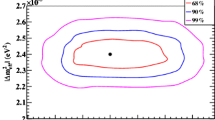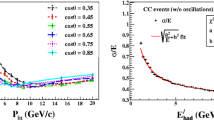Abstract
The iron calorimeter (ICAL) at India-based neutrino observatory (INO) is designed to mainly observe the muons produced in the charged current interactions of atmospheric muon neutrinos and antineutrinos. The track of the muon is reconstructed using the hits they produce in the detector. From this track, the charge, the energy and the direction of the muon are estimated, which are used to do oscillation physics analysis. In a large fraction of events, a number of hadrons are also produced in addition to the muons. The charged hadrons also leave hits in the detector which can be utilised to estimate the hadron energy. In this work, we generate atmospheric neutrino events using two different neutrino event generators: NUANCE and GENIE. The generated events are passed through the Geant4 simulator of ICAL. In each case, we study the relation between hadron hits, defined to be the difference between the total number of hits and the muon track hits, and the hadron energy. We find that a non-negligible number of baryons are produced in atmospheric neutrino interactions. For \({E}_\mathrm{had} < 5\) GeV, almost all the hadron energy is carried by these baryons. Finally, we formulate a procedure by which the hadron energy can be estimated from the number of hadron hits.












Similar content being viewed by others
References
S Ahmad et al, Pramana – J. Phys. 88: 79 (2017)
A Ajmi et al, Improving the hierarchy sensitivity of ICAL using neural network, arxiv:1510.02350 [physics.ins-det]
T Thakore et al, J. High Energy Phys. 05, 058 (2013)
A Ghosh et al, J. High Energy Phys. 04, 009 (2013)
M M Devi et al, J. Instrum. 08, P11003 (2013)
S Seth et al, J. Instrum. 13, P09015 (2018)
L S Mohan et al, J. Instrum. 9, T09003 (2014)
M M Devi et al, J. High Energy Phys. 2014, 189 (2014)
T Thakore, Physics potential of the India-based neutrino observatory (INO), Ph.D. thesis (DHEP, TIFR, Mumbai 2014)
D Casper, Nucl. Phys. B - Proc. Suppl. 112, 161 (2002)
C Andreopoulos et al, Nucl. Instrum. Methods A 614, 87 (2010)
P V Vavilov, Sov. Phys. JETP 5, 749 (1957)
Acknowledgements
The authors would like to thank Dr Ali Ajmi who provided valuable help in the initial stages of this work. They also thank Prof. Gobinda Majumder, Dr Susanta Seth, Prof. Prafulla Behera and Dr Jafar Sadiq for discussions at different times. Thanks are also due to Prof. Raj Gandhi and Prof. Amol Dighe who gave valuable feedback at various intermediate stages. Funding was provided by Department of Atomic Energy (IN).
Author information
Authors and Affiliations
Corresponding author
Rights and permissions
About this article
Cite this article
Nizam, M., Sankar, S.U. Hadron energy estimation from atmospheric neutrino events. Pramana - J Phys 94, 118 (2020). https://doi.org/10.1007/s12043-020-01986-x
Received:
Revised:
Accepted:
Published:
DOI: https://doi.org/10.1007/s12043-020-01986-x




